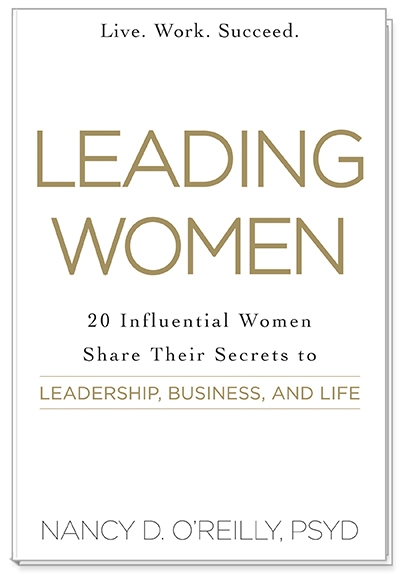Pursuing gender balance in the executive suite and boardroom is clearly a good business decision. Documented benefits include higher profits, better employee retention and a deeper talent pool.
But achieving that balance takes intentional focused efforts. On the company side, simply stating the goal does not ensure a flow of qualified women applying for the jobs. On the women’s side, they need to develop some new skills and alliances.
Dr. Nancy O’Reilly has long had a mission in support of filling the gender-diversity gap with a new generation of women leaders. That’s why she selected international leaders to contribute to her book, Leading Women: 20 Influential Women Share Their Secrets to Leadership, Business, and Life. The co-authors shared their wisdom, real-life stories and advice to help women conquer their internal barriers, claim their power and respect, and change the world by helping other women do the same. Each co-author offered immediately actionable steps to help women change their relationship with power, increase their confidence, and capitalize on their feminine skills.
The conscious business model identifies the value of feminine assets of collaboration, cooperation, vulnerability and big picture thinking. In the chapter, “Soft Is The New Hard,” Birute Regine details how feminine management transformed results for Kim Campbell, former Canadian Prime Minister, in negotiating a difficult piece of legislation.
When the bill was adopted, male observers assumed she must have watered it down to get it passed. But no, she used her feminine management skills to get the dissenting parties to talk to each other and negotiate. Obviously, this approach is not limited to women. Many men have long adopted feminine leadership techniques when it works best to get the job done. While these approaches come naturally to women, everyone with a conscious and open mind can learn to use them.
Opening to possibilities is the challenge of trying to change a culture while living in it. We remain stuck in the old culture where we expect men to earn the living and women to care for the family. Even though today most women are doing both, they aren’t getting the promotions, the pay or the support to propel them to the top of the organizations.
Women drop out of companies to start their own businesses. In fact, women-owned business is the fastest growing segment of US business start-ups. Companies are losing female talent before it even approaches the C-suite. And this female flight is getting worse. The brightest and the best of the new generation of millennials won’t even interview with a company that doesn’t include people who look like them, whether it’s women of color or a diversity of age and gender.
 Other chapters of Leading Women address issues and ideas that hold women back from attaining top leadership positions. Gloria Feldt addresses the fraught relationship women have with power. They shun “power over” others, having been victims of oppressive power in the past. But when Gloria reframes the paradigm as the “power to” accomplish their goals, women welcome power as a tool for success.
Other chapters of Leading Women address issues and ideas that hold women back from attaining top leadership positions. Gloria Feldt addresses the fraught relationship women have with power. They shun “power over” others, having been victims of oppressive power in the past. But when Gloria reframes the paradigm as the “power to” accomplish their goals, women welcome power as a tool for success.
Lois Phillips urges women to speak out and tells them how to use the podium to gain credibility and be seen and heard. If no one knows your wonderful ideas, how can you possibly get that promotion? M. Bridget Cook-Burch shows how recasting her own life story liberated her from old thought patterns, so she could embark on a new career and succeed in business.
The lesson here is that many women create their own glass ceilings. They don’t see themselves as leaders when the fact is that they lead in a myriad of ways every day. They limit their reach by being suspicious of other women in the workplace instead of clarifying motives and looking for ways to support one another in the climb up the corporate ladder. But most of all, the biggest hurdle to overcome is fear. Whether you avoid pursuing an idea because you’re afraid of failure, or afraid of how your life will change if you succeed, it’s the fear itself that stops us from even trying.
Licensed psychologist Nancy O’Reilly relates how she has learned to do what she most fears. Once she’s accomplished it and found it’s not that difficult, she tackles the next thing, and the next. This method of building self-confidence works so well, obstacles that once loomed like unscalable cliffs become little more than speed bumps along the way.
Internationally acclaimed author Dr. Lois Frankel says in her chapter, “Women have become natural and necessary leaders… by building relationships, motivating others to succeed, carefully crafting their communications, and creating environments of trust and safety.” When corporations truly appreciate the value of these qualities, more women will enter the C-suite to create the diversity and gender equality required for profitable and self-sustaining growth.




































